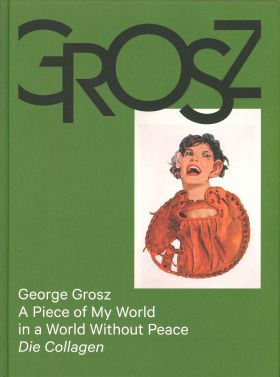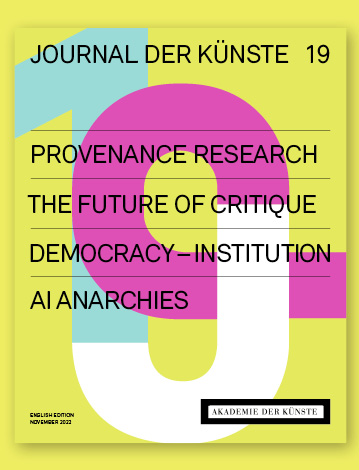Publications
Journal der Künste 23
Published three times a year (German/English), available free of charge
ISSN (Print EN) 2627-2490
not yet published
The first issue of Journal der Künste under the presidency of Manos Tsangaris and Anh-Linh Ngo focuses on artistic freedom. Texts by Lena Gorelik, Ralf Michaels, Carsten Wurm and others as well as a conversation with Kristóf Kelemen and Gergely Nagy from Hungary address the defence of artistic autonomy from various perspectives. Further contributions provide insights into the genesis of the current exhibitions and the work of the archive.

Michael Ruetz
Poesie der Zeit
éditions facteur cheval, Berlin 2024
German/English/French, 192 pp.,
365 ill.
ISBN 978-3-00-077996-1
Best.-Nr. 6050
out of print
How can time and transience be visualised? How can changes in a society or an urban space be documented? Since the mid-1960s, artist Michael Ruetz has been observing the transformation of natural and urban environments at places in Berlin, Germany and Europe in a photographic study. His works, called Timescapes, comprise more than 600 locations and thousands of photographs. The central concept of Timescapes is that the position and visual axis of the camera always remain the same, while only the time intervals of the photo series vary.

Michael Ruetz Timescapes Poetry of Time
Akademie der Künste, Berlin 2024
German/English, 45 ill.
5 photo booklets
ISBN 978-3-88331-258-3
Best.-Nr. 6049
€ 15
How can time and impermanence be rendered visible, and how can the upheavals and changes taking place in a society or an urban space be documented? Few other artists have concerned themselves with these questions to the extent that Michael Ruetz has. In the mid-1960s, he embarked on a large-scale photographic study to observe the transformation of natural and urban environments in Germany and Europe. Ruetz has recorded the metamorphoses in photographic series made up of images inventorying the changes and snapshots taken over decades. He calls them Timescapes.

Journal der Künste 22
Published three times a year (German/English), available free of charge
ISSN (Print EN) 2627-2490
The Journal der Künste, issue 22, bids farewell to Jeanine Meerapfel and Kathrin Röggla, the Akademie’s former president and vice-president. It explores the possibility of utopias with Matěj Spurný, Eva von Redecker and Iris ter Schiphorst and the political shift to the right in Germany with Thomas Krüger, Christina Clemm and Holger Bergmann. The 2023 Kollwitz Prize recipient, Sandra Vásquez de la Horra, shows works from her oeuvre; and a Carte blanche designed by Wolfgang Tillmans is featured. The archive includes the stories behind a photomontage by István Szabó and newly acquired drawings by George Grosz, as well as insights into Jürgen Flimm’s director’s workshop.

George Grosz: A Piece of My World in a World without Peace. Die Collagen
Birgit Möckel, Rosa von der Schulenburg
Verlag der Buchhandlung Walther und Franz König, Köln 2024
German, 172 pp.,
180 ill.
ISBN 978-3-7533-0531-8
Best.-Nr. 1215
€ 35
Collages made from photo materials taken from print media played a significant role in George Grosz’s works, especially during his early period in Berlin and his final years in the United States. Both female and male stereotypes and their counterparts recur, as do props from everyday life and the consumer world, aptly commenting on the society of their times. The catalogue includes all the works in the exhibition. The texts present the most recent findings on collage in Grosz’s oeuvre, drawing associations to comparable works by Erwin Blumenfeld, Herbert Fiedler and Hannah Höch.

Kalender 2024: DDR-Plakate
Weingarten
Akademie der Künste, Berlin / Athesia Kalenderverlag GmbH, Unterhaching 2023
German, 14 pp.,
12 ill.
ISBN 978-3-8400-8494-2
Best.-Nr. 1210
out of print
Frosty noses are smiled away, the floor is cleaned with ease, clothes and special groceries are bought at Konsum and HO. Even Father Christmas is a regular customer, ho ho ho. Pure experiences, whether in the shower or on holiday. With this calendar, the year will never be boring.

Journal der Künste 19
Published three times a year (German/English), available free of charge
ISSN (Print EN) 2627-2490
The new issue looks at the crisis of public broadcasting as an instrument of democracy, at how art deals with the societal challenges of artificial intelligence, and at the changing role of (art) criticism. Other focal points: the current archive exhibition “Spurensicherung,” photographs by Nan Goldin and Aleš Šteger on artistic freedom in Europe.
To order the print edition: info@adk.de

Otto Nagel – Menschensucher und Sozialist
Eckhart J. Gillen im Auftrag der Stadt Eberswalde, in Zusammenarbeit mit der Akademie der Künste, Berlin
Akademie der Künste, Berlin / Stadt Eberswalde, Kulturamt, Eberswalde 2022
German, 116 pp.,
60 ill.
ISBN 978-3-88331-251-4
Best.-Nr. 1207
€ 10
The academic catalogue accompanies the exhibition of paintings and pastels by “Wedding classic” Otto Nagel from the art collection of the Akademie der Künste in the Regionalmuseum Eberswalde. Based on research, especially in the Akademie’s Visual Arts Archive, the authors discover astonishing new facets in the life and work of this outstanding 20th-century realist.

Kalender 2023: DDR-Plakate
Weingarten
Akademie der Künste, Berlin / Athesia Kalenderverlag GmbH, Unterhaching 2022
German, 14 pp.,
13 ill.
ISBN 978-3-8400-8358-7
Best.-Nr. 1203
out of print
The best GDR design of the 1950s from the Akademie’s own poster collection will take you through a cheerful 2023. Twelve motifs offer a variety of insights into a colourful advertising world: Under the motto “snug and cosy warmth”, people cuddle up in Konsum clothing to combat everyday worries, Wellaform puts a gloss on hair and a laughing sausage ensures a “Bon appétit!”

Journal der Künste 18
Published three times a year (German/English), available free of charge
ISSN (Print EN) 2627-2490
Pictures from Ukraine by Mila Teshaieva and Johanna-Maria Fritz open issue 18. The focus of the issue is the global ecological crisis: with contributions on the Japanese Edo period as a model for an art of sustainability, on the problematic role of copper, on dealing with climate protection issues through musical interventions, and more. It also includes a travel diary by Jeanine Meerapfel on the trail of Walter Benjamin, an interview with Berlin Biennale curator Kader Attia, drawings by Milein Cosman and a look at the newly opened Gerhard Leo Archive.
To order the print edition: info@adk.de

Calendar 2021: GDR Posters
Akademie der Künste, Berlin / KV&H Verlag Weingarten, Unterhaching 2020
German, 14 pp., 13 ill.
ISBN 978-3-8400-8007-4
Order no. 1196
out of print
Corn is sausage on a stick! The poster art of the GDR combines snappy slogans with impressive graphic design and a pinch of politics. Twelve original motifs from the 1950s and 1960s from the Akademie der Künste poster collection will accompany you through 2021, promoting wholefood nutrition, compensatory gymnastics, road safety and shopping at HO or Konsum.

John Heartfield. Photography plus Dynamite
Angela Lammert, Rosa von der Schulenburg and Anna Schultz on behalf of the Akademie der Künste, Berlin (Eds.), Akademie der Künste, Berlin / Hirmer Verlag 2020 312 pages, 250 illustrations ISBN 978-3-7774-3443-8 (English edition) € 39,90
The political photomontages and collaged book covers of John Heartfield (1891–1968) have their origins in Berlin Dada. With gripping imagery and trenchant humour, the artist fought against war and Fascism, using works whose explosive power has lost none of its impact today. Like his animated films and theatre work, they are discussed in the context of his own and others' artworks, as well as the archive materials and images he collected. Supplemented by contemporary artists' statements.

Kalender 2020: DDR-Plakate
Akademie der Künste, Berlin / KV&H Verlag Weingarten 2019
German, 14 pp.,
13 ill.
ISBN 9783840077852
Best.-Nr. 1192
out of print
How about a bit more? DEWAG was a state-run agency in the GDR responsible for both political communication and product advertising. Twelve new designs of the 1950s and 1960s from the poster collection of the Akademie der Künste, accompanied by short texts by Matthias Biskupek, inform the public about harvest festivals, healthy nutrition, tights and “cute summer sandals”.

Nina Schleif
Schlachter des guten Gewissens.
Der Zeichner Paul Holz 1883–1938
Kunstforum Ostdeutsche Galerie Regensburg (ed.)
Klinkhardt & Biermann, Munich, 2018
German
176 pp., 164 ills.
ISBN 978-394361-6-53-8
€ 34,95
Paul Holz (1883–1938) was one of the most exceptional German illustrators of the 20th century. Nevertheless, he was denounced as "degenerate" after 1933 and has only gained increasing appreciation since 1990. To commemorate of the 80th anniversary of his death, the catalogue presents all works in the possession of Kunstforum Ostdeutsche Galerie in Regensburg, as well as outstanding drawings from the Akademie der Künste, whose art collection is home to the most extensive collection of works by Paul Holz.

GDR Posters
Calendar 2019
Akademie der Künste / KV&H Verlag, Weingarten, 2018
Wall calendar
German
Best.-Nr. 1186
out of print
Winter Service, "Haferkakao" (oat cocoa), Baltic Sea Week and Tanning Cream! In the 1950s, design and advertising content were as varied as the product range of the planned economy was manageable. Twelve more motifs from the poster collection of the Akademie der Künste with short texts by Matthias Biskupek offer insights into the world of GDR advertising graphics.

GDR Posters
Calendar 2018
Akademie der Künste / KV&H Verlag, Weingarten, 2017
Wall calendar
Best.-Nr. 1179
€ 16,99
The controlled economy of the GDR advertised a straightforward range of products in surprising, ingenious and effective ways. Twelve colourful motifs from the Akademie der Künste’s poster collection offer insights into the wonderful, funny and effective world of GDR advertising from the 1950s. With short texts by Matthias Biskupek.

Alice Lex-Nerlinger
1893–1975
Fotomonteurin und Malerin
Marion Beckers (ed.) for Das Verborgene Museum in collaboration with Akademie der Künste, Berlin, Lukas Verlag, Berlin 2016,
German/English, 192 pp., ill.
ISBN 978-3-86732-245-4
€ 30
Painter and graphic artist Alice Lex-Nerlinger belonged to the artistic and political avant-garde in the Weimar Republic. She became famous for her work §218 (1931) attacking the law on banning abortion. Influenced by "Der Sturm" gallery's circle of artists, she started to work with modern techniques such as photography, montage and photograms. The catalogue for the exhibition in Das Verborgene Museum contains many documents and illustrations from the artist’s estate now in the Akademie der Künste Archive and art collection.